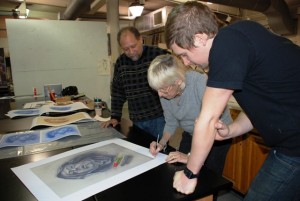Genna Asselin ’15 (Mendham, N.J.) had a hand in creating a professional print which has been placed in the Yale Art Gallery’s permanent collection.

Genna Asselin ’15 puts the finishing touches on “The Ecstasy of Saint Theresa.”
Asselin, an art and chemistry double major, worked on “The Ecstasy of Saint Theresa” by painter Audrey Flack with Curlee Holton, Roth Professor of Art and director of the Experimental Printmaking Institute (EPI), and Jase Clark, master printer in training and shop manager at EPI.
The print was created over a six-month period in which Flack was intimately involved. This process began with working from original drawings that were reworked and printed multiple times to produce the final print. The process involved digital imagery and serigraph printing techniques. A number of the processes were developed at EPI under Clark’s direction.
Asselin assisted in all phases of the printing and was responsible for the final curatorial process that checked each print and trimmed them for final presentation.
“This experience introduced Genna to a major American artist,” says Holton. “A young female student meeting and working with a successful female artist who mentors you is rare.”
Flack is a pioneer of Photorealism and a nationally recognized painter and sculptor whose work is in the collections of major museums around the world. “The Ecstasy of Saint Theresa” is the first in a series of major drawings by Flack that have never been shown, all of which will be published by EPI.

Professor Curlee Holton, painter Audrey Flack, and Jase Clark, master printer in training, look over a final proof.
“She knew exactly what she wanted and she was not afraid to say it if she wanted to change something,” says Asselin. “She very much has a vision and a strong point of view. It is very humbling working with a successful artist because you know they worked hard to be where they are now.”
Asselin plans to have a career in art restoration and conservation, and her upcoming summer internship will give her valuable experience in the field. Asselin will spend two months in Venice, Italy, working with Save Venice, a non-profit art restoration organization.
For this type of work, Asselin’s two majors complement each other perfectly. Chemistry plays a big part in art restoration and conservation, including performing chemical analyses, and applying chemicals to safely clean or preserve the work.

